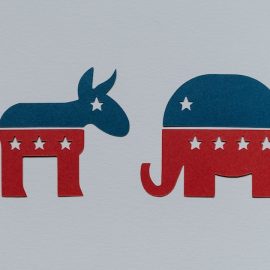
This is a free excerpt from one of Shortform’s Articles. We give you all the important information you need to know about current events and more.
Don't miss out on the whole story. Sign up for a free trial here .
Are affirmative action policies still relevant in 2023? Why do some lawmakers want to eliminate affirmative action policies?
The Supreme Court will soon decide whether to eliminate affirmative action policies. One side says these policies are still needed to create a just society. The other says they create reverse discrimination.
We’ll look at both sides of the debate here.
What Is Affirmative Action?
Before we discuss the question “Does affirmative action work?” here’s a background on affirmative action. Affirmative action is a set of policies and practices designed to increase the representation of historically disadvantaged groups, such as racial minorities and women, in education and employment. President John F. Kennedy first used the phrase in a 1961 executive order requiring government agencies to “take affirmative action to ensure that applicants are employed, and employees are treated during employment, without regard to their race, creed, color, or national origin.”
In this article, we’ll examine both sides of the debate around affirmative action, and consider whether there might be other ways to address the ongoing issues around discrimination and inequality.
Side 1: Affirmative Action Works and Is Necessary
Advocates of affirmative action policies point out that the US still doesn’t have a system of equal opportunity, because some groups have been at a disadvantage historically. This means those groups remain underrepresented in colleges and universities, and therefore they won’t have equal access to career opportunities. Specifically, this underrepresentation in college is a direct result of lifelong disadvantages in education due to differences in funding, curricula and teacher quality, and class size in the public education system.
Some of the reasons advocates of affirmative action say we need to keep these policies in place include:
- Reducing discrimination: One of the primary goals of affirmative action is to reduce discrimination against underrepresented groups. By providing these groups with greater opportunities in education and employment, affirmative action aims to create a more equal society where everyone has a fair chance to succeed.
- Addressing historical injustices: Affirmative action is seen as a way to address the historical injustices that have led to this underrepresentation of certain groups in education and employment.
- Promoting diversity: Affirmative action can help promote diversity in schools and workplaces. This can lead to better relationships between people of different backgrounds, which can be beneficial for everyone involved.
Supporters of affirmative action say that abolishing the practice could lead to reduced diversity in schools and workplaces, continued discrimination against disadvantaged groups, and increased resentment and division between groups—all of which would have negative consequences for society.
Side 2: Affirmative Action Doesn’t Work and Should Be Eliminated
On the other hand, objectors to affirmative action argue that these kinds of policies are not the appropriate way to address inequalities, because they’re ultimately just unfair to different groups. The cases currently in the Supreme Court contend that admissions policies at these two colleges are discriminatory against Asian and white students. In other words, they argue that discrimination by race is not the way to end discrimination by race.
Some of the specific critiques of affirmative action policies include:
- Reverse discrimination: One of the primary criticisms of affirmative action (including in the current Supreme Court cases) is that it can lead to reverse discrimination against individuals who are not part of historically underrepresented groups. This can be seen as unfair to those who may be more qualified for a job or a spot in a university but are passed over in favor of someone who is part of a minority group.
- Meritocracy: In addition to being unfair to some groups, critics claim that affirmative action undermines the principle of meritocracy, a system in which people are rewarded for their abilities, talent, and effort.
- Stigmatization: Some also argue that affirmative action can lead to the stigmatization of the very groups it’s intended to help by creating the impression that these groups are less capable and need special treatment in order to succeed.
- Resentment and division: Affirmative action can also create resentment and division between groups because some may feel that they are being penalized for their race or gender.
Those who support ending affirmative action believe we should focus only on qualifications and abilities, without regard to race or gender, in education and the workplace. And this sentiment is supported by a majority of Americans. A 2022 Pew poll showed that 74% of Americans didn’t believe race or ethnicity should be a factor in college admissions, and 82% didn’t support consideration of gender. The majority supported giving the strongest consideration to high school grades and standardized test scores.
Looking to the Future: How Can We Create Equal Opportunity?
Those on both sides of this debate appeal to equal opportunity as an important value; they just disagree on what that means and how to achieve it. If America is to embody the principles of equality laid out in the Declaration of Independence, we’ll need to talk about alternative ways to address the systemic inequalities that exist. This raises broader questions about resource allocation and the principles of meritocracy.
Investing In Opportunity Creation
In some states where affirmative action policies have already been banned, there’s been a steady decline in minority student populations on campus. For example, Michigan banned race consideration in college admissions in 2006, and the Black student population at the University of Michigan declined from 9% to 4% within a few years.
Adam Harris, author of The State Must Provide: Why America’s Colleges Have Always Been Unequal—and How to Set Them Right, argues that an important step toward equal opportunity for Black Americans would be allocating more resources to historically Black colleges and universities (HBCUs). He says endowments for Black colleges are only around half the size of those for white colleges, and the states often fail to fund Black colleges at the same rate as majority-white ones.
Creating a True Meritocracy
Finally, if we truly want a system based on meritocracy, other kinds of changes would also have to be made to college admissions policies. Examination of admissions practices at elite schools shows that, beyond race and gender, there are other non-meritocratic factors going into these decisions. For example, there are more students from the top 1% income bracket at these schools than there are from the bottom 60%, and those students tend to be white and don’t necessarily have better high school grades.

Want to fast-track your learning? With Shortform, you’ll gain insights you won't find anywhere else .
Here's what you’ll get when you sign up for Shortform :
- Complicated ideas explained in simple and concise ways
- Smart analysis that connects what you’re reading to other key concepts
- Writing with zero fluff because we know how important your time is






